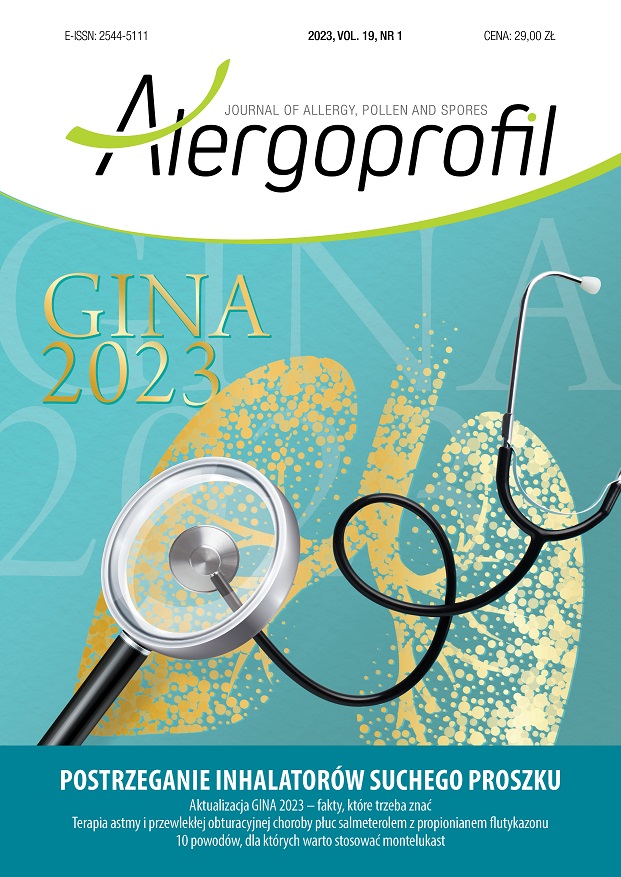10 powodów, dla których warto stosować montelukast Artykuł przeglądowy
##plugins.themes.bootstrap3.article.main##
Abstrakt
Montelukast, najczęściej stosowany z leków antyleukotrienowych, wykorzystywany jest w terapii astmy (zalecenia GINA) i astmy z alergicznym nieżytem nosa. Z uwagi na zróżnicowanie: mnogość fenotypów i endotypów astmy, warto pamiętać o możliwości terapii monteluka-stem, zwłaszcza w przypadkach: pacjentów z astmą aspirynową, astmy u osób otyłych, astmy u osób palących tytoń, astmy, która pogarsza się w dokuczliwy sposób w przebiegu infekcji, astmy pacjentów pediatrycznych, kiedy terapia inhalacyjna nastręcza trudności.
Pobrania
##plugins.themes.bootstrap3.article.details##
Copyright: © Medical Education sp. z o.o. This is an Open Access article distributed under the terms of the Attribution-NonCommercial 4.0 International (CC BY-NC 4.0). License (https://creativecommons.org/licenses/by-nc/4.0/), allowing third parties to copy and redistribute the material in any medium or format and to remix, transform, and build upon the material, provided the original work is properly cited and states its license.
Address reprint requests to: Medical Education, Marcin Kuźma (marcin.kuzma@mededu.pl)
Bibliografia
2. Serhan ChN, Wasserman SI. The allergy archives: pioneer and milestones. The discovery and characterization of the leukotrienes. J Allergy Clin Immunol. 2006; 118(4): 972-80.
3. Pawliczak R. Leki antyleukotrienowe. In: Fala AM (ed). Alergia, choroby alergiczne, astma. Vol. 2. Medycyna Praktyczna, Warszawa 2011: 112-9.
4. Kuna P, Kupczyk M. Antagoniści receptora leukotrienowego (cysLT1) i inne leki przeciw-leukotrienowe. In: Fala AM (ed). Farmakoterapia astmy i chorób alergicznych. Termedia Wydawnictwa Medyczne, Poznań 2012: 177-97.
5. Peters-Golden M, Henderson WR. Leukotirens. N Engl J Med. 2007; 357: 1841-54.
6. Holgate ST, Peters-Golden M, Panettieri R et al. Roles of cysteinyl leukotriens in airway inflammation, smooth muscle function and remodeling. J Allergy Clin Immunol. 2003; 111: 18-36.
7. Przybylski J. Leki przeciwleukotrienowe – nowy kierunek terapii chorób o podłożu alergicznym. Farm Pol. 2005; 61(3): 124-32.
8. Meltzer EO, Malmstrom K, Lu S et al. Concomitant montelukast and loratadine as treatment for seasonal allergic rhinitis: a randomized, placebo-controlled clinical trial. J Allergy Clin Immunol. 2000; 105: 917-22.
9. Nayak A, Langdon RB. Montelukast in the treatment of allergic rhinitis: an evidence-based review. Drugs. 2007; 67: 887-901.
10. Van Adelsberg J, Philip G, LaForce CF et al. Randomized controlled trial evaluating the clinical benefit of montelukast for treating spring seasonal allergic rhinitis. Ann Allergy Asthma Immunol. 2003; 2: 214-22.
11. Nayak AS, Philip G, Lu S et al. Efficacy and tolerability of montelukast alone or in combination with loratadine in seasonal allergic rhinitis: a multicenter, randomized, doubl-blind, placebo-controlled trial performed in the fall. Ann Allergy Asthma Immunol. 2002; 6: 592-600.
12. GINA: Main Report 2023 (access: 7.07.2023).
13. Charakterystyka produktu leczniczego Promonta 10 mg tabletki. https://rejestrymedyczne.ezdrowie.gov.pl/api/rpl/medicinal-products/20123/characteristic (access: 7.07.2023).
14. Montuschi P, Peters -Golden M. Leukotriene modifiers for asthma treatment. Clin Exp Allergy. 2010; 40: 1732-41.
15. Busse W, Raphael GD, Galant S et al. Fluticasone Proprionate Clinical Research Study Group. Low-dose fluticasone propionate compared with montelukast for first-line treatment of persistent asthma: a randomized clinical trial. J Allergy Clin Immunol. 2001; 107: 461-8.
16. Baffi CW, Winnica DE, Holguin F. Asthma and obesity: mechanisms and clinical implications. Asthma Res Pract. 2015; 1: 1.
17. Micheletto C, Tognella S, Visconti M et al. Montelukast 10 mg improves nasal function and nasal response to aspirin in ASAsensitive asthmatics: a controlled study v. placebo. Allergy. 2004; 3: 289-94.
18. Barnes NC, Miller CJ. Effect of leukotriene receptor antagonist therapy on the risk of asthma exacerbations in patients with mild to moderate asthma: an integrated analysis of zafirlukast trials. Thorax. 2000; 55: 478-83.
19. Ragnoli B, Pochetti P, Raie A et l. Interrelationship Between Obstructive Sleep Apnea Syndrome and Severe Asthma: From Endo-Phenotype to Clinical Aspects. Front Med (Lausanne). 2021; 8: 640636.
20. Bisgaard H, Skoner D, Boza ML et al. Safety and tolerability of montelukast in placebo-controlled pediatric studies and their open-label extensions. Pediatr Pulmonol. 2009; 44: 568-79.
21. Anderson SD. Single-dose agents in the prevention of exercise- induced asthma: a descriptive review. Treat Respir Med. 2004; 3(6): 365-79.
22. Melo RE, Sole D, Naspitz CK. Exercise-induced bronchoconstriction in children: montelukast attenuates the immediate- phase and late-phase responses. J Allergy Clin Immunol. 2003; 111: 301-7.
23. Kowalski M, Jędrzejczak M, Cirlic M. Efektywność leczenia astmy oskrzelowej w Polsce w ocenie pacjentów – wyniki badania AIRCEE (Asthma Insights & Reality in Central and Eastern Europe). Alergia Astma Immunologia. 2004; 9(4): 187-95.
24. Knorr B, Franchi LM, Bisgaard H et al. Montelukast, a leukotriene receptor antagonist, for the treatment for persistent asthma in children aged 2 to 5 years. Pediatrics. 2001; 108: E48.
25. Lipworth BJ. Leukotriene-receptor antagonists. Lancet. 1999; 353(9146): 57-62.

